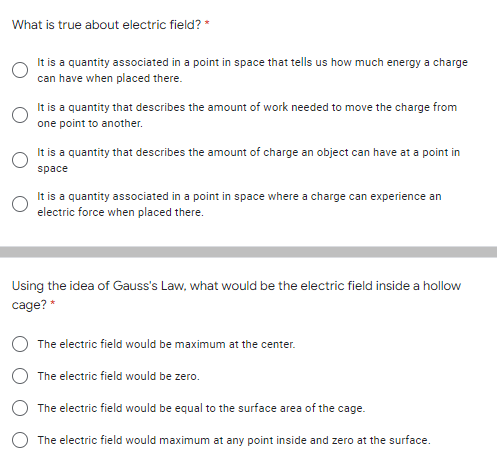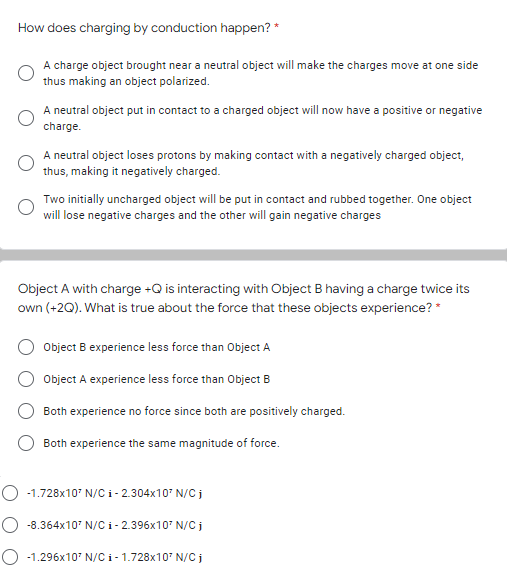What is true about electric field? * It is a quantity associated in a point in space that tells us how much energy a charge can have when placed there. It is a quantity that describes the amount of work needed to move the charge from one point to another. It is a quantity that describes the amount of charge an object can have at a point in space It is a quantity associated in a point in space where a charge can experience an electric force when placed there. Using the idea of Gauss's Law, what would be the electric field inside a hollow cage? * The electric field would be maximum at the center. The electric field would be zero. The electric field would be equal to the surface area of the cage. The electric field would maximum at any point inside and zero at the surface.
What is true about electric field? * It is a quantity associated in a point in space that tells us how much energy a charge can have when placed there. It is a quantity that describes the amount of work needed to move the charge from one point to another. It is a quantity that describes the amount of charge an object can have at a point in space It is a quantity associated in a point in space where a charge can experience an electric force when placed there. Using the idea of Gauss's Law, what would be the electric field inside a hollow cage? * The electric field would be maximum at the center. The electric field would be zero. The electric field would be equal to the surface area of the cage. The electric field would maximum at any point inside and zero at the surface.
Principles of Physics: A Calculus-Based Text
5th Edition
ISBN:9781133104261
Author:Raymond A. Serway, John W. Jewett
Publisher:Raymond A. Serway, John W. Jewett
Chapter6: Energy Of A System
Section: Chapter Questions
Problem 34P
Related questions
Question

Transcribed Image Text:What is true about electric field? *
It is a quantity associated in a point in space that tells us how much energy a charge
can have when placed there.
It is a quantity that describes the amount of work needed to move the charge from
one point to another.
It is a quantity that describes the amount of charge an object can have at a point in
space
It is a quantity associated in a point in space where a charge can experience an
electric force when placed there.
Using the idea of Gauss's Law, what would be the electric field inside a hollow
cage? *
The electric field would be maximum at the center.
The electric field would be zero.
The electric field would be equal to the surface area of the cage.
The electric field would maximum at any point inside and zero at the surface.

Transcribed Image Text:How does charging by conduction happen? *
A charge object brought near a neutral object will make the charges move at one side
thus making an object polarized.
A neutral object put in contact to a charged object will now have a positive or negative
charge.
A neutral object loses protons by making contact with a negatively charged object,
thus, making it negatively charged.
Two initially uncharged object will be put in contact and rubbed together. One object
will lose negative charges and the other will gain negative charges
Object A with charge +Q is interacting with Object B having a charge twice its
own (+20). What is true about the force that these objects experience? *
Object B experience less force than Object A
Object A experience less force than Object B
Both experience no force since both are positively charged.
Both experience the same magnitude of force.
O 1.728x10' N/Ci - 2.304x10' N/C j
O -8.364x107 N/C i- 2.396x10' N/C j
O -1.296x10' N/C i- 1.728x10 N/C j
Expert Solution
This question has been solved!
Explore an expertly crafted, step-by-step solution for a thorough understanding of key concepts.
Step by step
Solved in 5 steps with 1 images

Knowledge Booster
Learn more about
Need a deep-dive on the concept behind this application? Look no further. Learn more about this topic, physics and related others by exploring similar questions and additional content below.Recommended textbooks for you

Principles of Physics: A Calculus-Based Text
Physics
ISBN:
9781133104261
Author:
Raymond A. Serway, John W. Jewett
Publisher:
Cengage Learning

College Physics
Physics
ISBN:
9781938168000
Author:
Paul Peter Urone, Roger Hinrichs
Publisher:
OpenStax College

Physics for Scientists and Engineers, Technology …
Physics
ISBN:
9781305116399
Author:
Raymond A. Serway, John W. Jewett
Publisher:
Cengage Learning

Principles of Physics: A Calculus-Based Text
Physics
ISBN:
9781133104261
Author:
Raymond A. Serway, John W. Jewett
Publisher:
Cengage Learning

College Physics
Physics
ISBN:
9781938168000
Author:
Paul Peter Urone, Roger Hinrichs
Publisher:
OpenStax College

Physics for Scientists and Engineers, Technology …
Physics
ISBN:
9781305116399
Author:
Raymond A. Serway, John W. Jewett
Publisher:
Cengage Learning

Physics for Scientists and Engineers: Foundations…
Physics
ISBN:
9781133939146
Author:
Katz, Debora M.
Publisher:
Cengage Learning

College Physics
Physics
ISBN:
9781285737027
Author:
Raymond A. Serway, Chris Vuille
Publisher:
Cengage Learning

College Physics
Physics
ISBN:
9781305952300
Author:
Raymond A. Serway, Chris Vuille
Publisher:
Cengage Learning